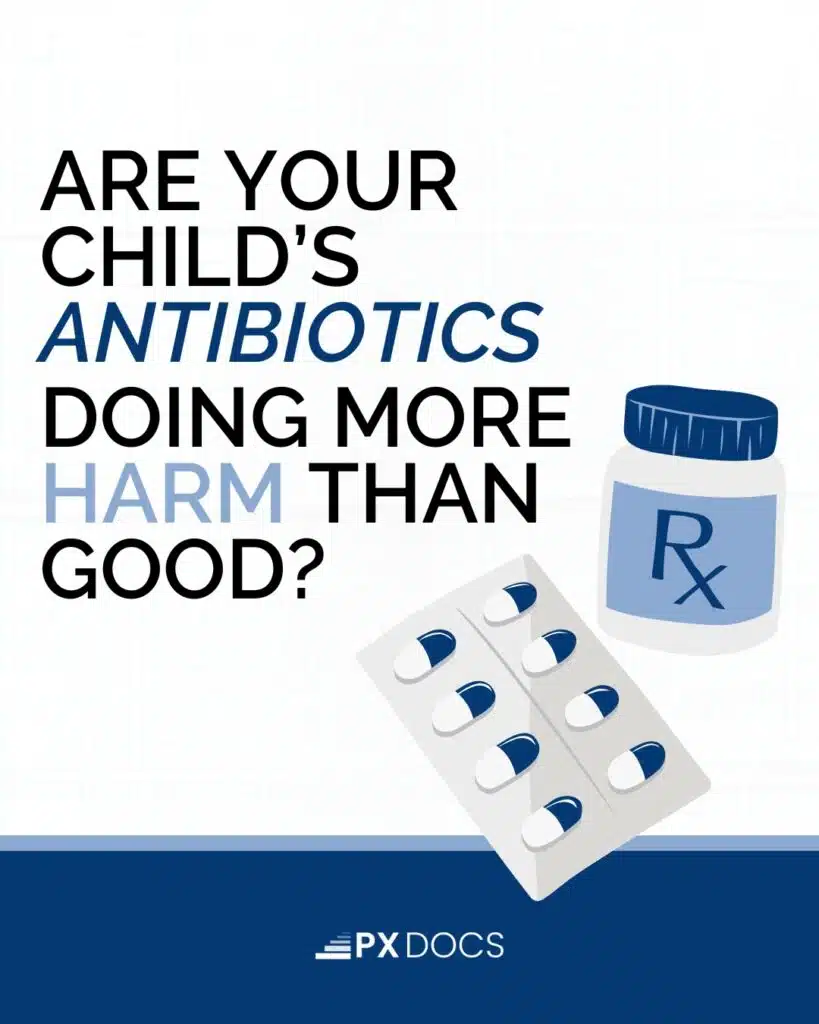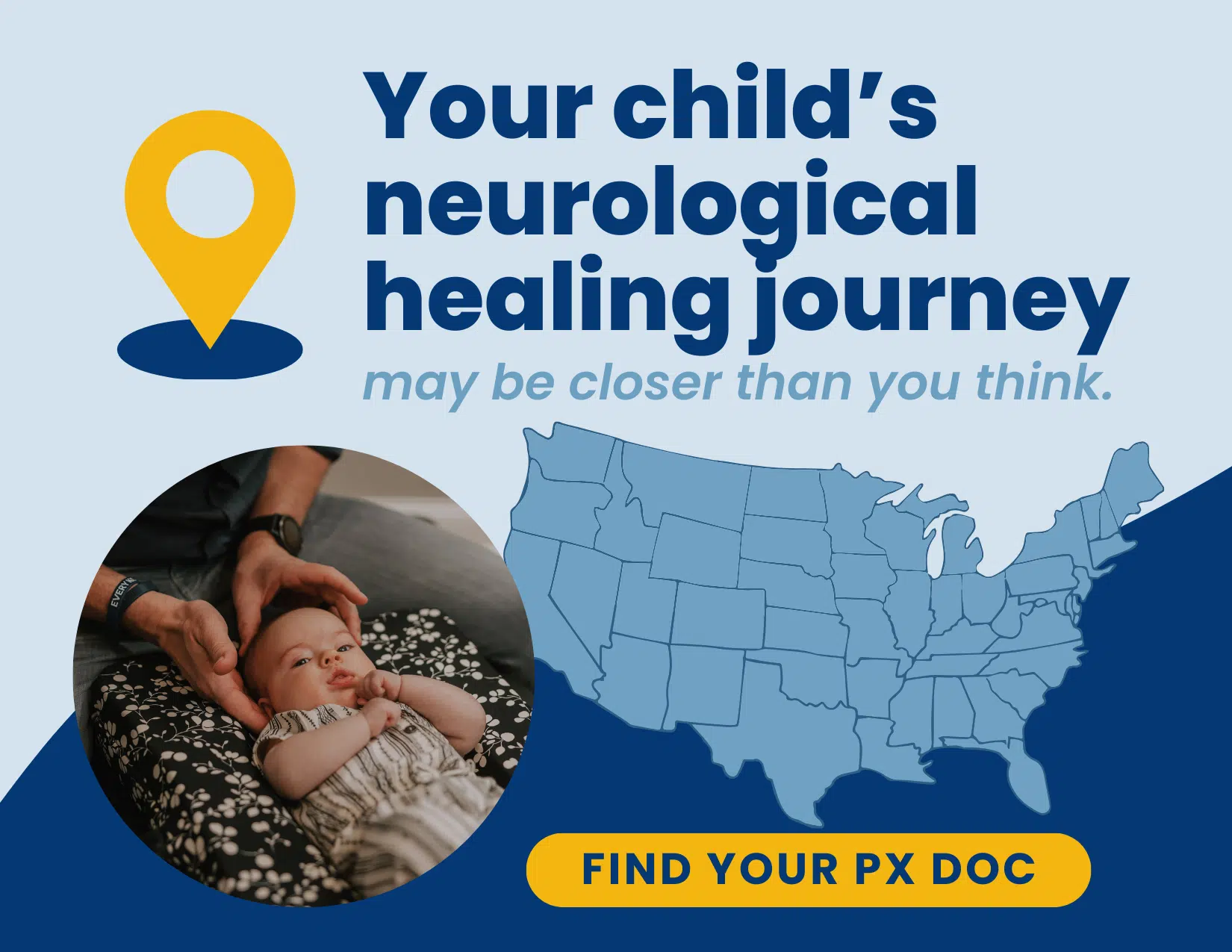If you’ve ever met a child who seems to always be on antibiotics, or if your own child is being prescribed antibiotics for nearly every issue, from a cold to chronic ear infections, you’re not alone. Studies reveal that doctors prescribed antibiotics to children for bacterial infections twice as often as needed, with nearly 50% of prescriptions being unnecessary or inappropriate.
At PX Docs, we educate patients about the dangers of antibiotic overuse, especially in children under three. Parents are usually surprised to learn about the long-lasting side effects. They frequently express frustration with their pediatricians for not providing this information when prescribing antibiotics for common issues like ear infections, sinus infections, and other respiratory illnesses.
Unfortunately, while medical organizations have updated their guidelines and stewardship regarding antibiotic prescriptions, it seems it will take much longer for practicing doctors to follow suit. This is why parents must educate and empower themselves with the knowledge to make informed decisions about their child’s healthcare.
In this article, we’ll explore the short-term and long-term side effects of antibiotics and discuss how a neurologically focused approach to pediatric care can help support your child’s natural defenses against bacterial infections without relying on antibiotics. By the end, you’ll be equipped with the information needed to keep your child healthy and drug-free.
Common Short-Term Side Effects of Antibiotics
While the different types of antibiotics can be life-saving when used appropriately, they can also cause a range of short-term side effects that may be uncomfortable or even dangerous for children. Some of the most common antibiotic side effects include:
Digestive Issues
Antibiotics can disrupt the delicate balance of gut bacteria, leading to digestive problems such as:
- Nausea and vomiting
- Diarrhea
- Abdominal pain and cramping
These side effects occur because antibiotics kill harmful bacteria and beneficial gut flora that aid digestion and nutrient absorption. This imbalance can lead to inflammation and irritation in the digestive tract.
Allergic Reactions
Some children may experience allergic reactions to antibiotics, ranging from mild to severe. Mild reactions may include:
- Skin rash
- Itching
- Hives
In rare cases, a severe allergic reaction called anaphylaxis can occur, causing difficulty breathing, swelling of the throat, and a rapid heartbeat. If your child experiences any signs of a severe allergic reaction, seek emergency medical attention immediately.
Fungal Infections
As antibiotics disrupt the natural balance of microbes in the body, they can create an environment where fungal overgrowth occurs. Common fungal infections associated with antibiotic use include:
- Oral thrush: White patches on the tongue, inner cheeks, and throat
- Vaginal yeast infections: Itching, burning, and a thick, white discharge
These infections can be uncomfortable and may require antifungal medication.
Tips for Managing Short-Term Side Effects of Antibiotics
If your child experiences mild antibiotic side effects, there are some steps you can take to help them:
- Encourage them to stay hydrated by drinking plenty of water or clear liquids
- Offer small, frequent meals if they are experiencing digestive issues
- Use natural and organic anti-itch creams or oral antihistamines for mild allergic reactions, as directed by your healthcare provider
It’s essential to remember that while these short-term side effects can be unpleasant, they are just one piece of the puzzle regarding the potential risks associated with antibiotic use.
How Long Do Antibiotics Stay in Your System? The Long-Term Side Effects of Antibiotics
While antibiotics’ short-term side effects can be unpleasant, parents must understand the potential long-term and even life-threatening consequences that may not be immediately apparent. These implications can profoundly impact your child’s health and well-being, making it essential to use antibiotics judiciously and only when absolutely necessary.

Antibiotic Resistance
One of the most significant long-term risks associated with antibiotic overuse, and one of the top threats to public health, is antibiotic resistance. When antibiotics are used inappropriately or excessively, bacteria can adapt and evolve, becoming resistant to the drugs designed to eliminate them.
In 2019, the Centers for Disease Control and Prevention (CDC) estimated that at least 2.8 million people in the United States contract antibiotic-resistant infections each year, resulting in more than 35,000 deaths. As antibiotic resistance increases, addressing infections, such as urinary tract infections, becomes increasingly challenging, leading to prolonged illnesses, higher healthcare costs, and even life-threatening situations.
To help combat antibiotic resistance, it’s essential to:
- Never share or use leftover antibiotics
- Practice good health and immune support to prevent the spread of infections
- Only use antibiotics when prescribed by a healthcare professional
Gut Microbiome Disruption
The human gut is home to trillions of bacteria, collectively known as the gut microbiome. This complex ecosystem plays a crucial role in digestion, nutrient absorption, immune function, and even mental health. Antibiotics, while targeting harmful bacteria, can also disrupt the delicate balance of the gut microbiome.
Research has shown that antibiotic use, particularly in early life, can lead to long-lasting changes in the gut microbiome. These alterations have been linked to an increased risk of various health problems, including:
- Obesity
- Inflammatory bowel disease
- Allergies and asthma
- Autoimmune disorders
Promoting a healthy gut microbiome through proper nutrition, probiotics, and limiting unnecessary antibiotic exposure can help mitigate these risks.
Neurotransmitter Imbalances
The gut-brain connection is a fascinating area of research that highlights the intricate relationship between digestive health and mental well-being. Neurotransmitters, such as serotonin and dopamine, play a vital role in regulating mood, behavior, and cognitive function. Surprisingly, a significant portion of these neurotransmitters are produced in the gut.
When antibiotics disrupt the gut microbiome, they can also interfere with the production and absorption of neurotransmitters. This imbalance may contribute to an increased risk of mental health concerns, such as anxiety, depression, and attention-deficit/hyperactivity disorder (ADHD).
Supporting your child’s gut health and being mindful of the potential impact of antibiotics on neurotransmitter balance is essential for their overall well-being.
“The Perfect Storm”: How Antibiotics Contribute to Chronic Health Issues
As we’ve seen, antibiotics can have both short-term and long-term effects on a child’s health. However, it’s essential to understand that antibiotic use is just one piece of a larger puzzle when it comes to the development of chronic health issues in children.
At PX Docs, we refer to this phenomenon as “The Perfect Storm“—a combination of factors that, when occurring together, can profoundly impact a child’s long-term health and well-being. These factors include:
- Fertility challenges
- Maternal stress during pregnancy
- Birth interventions and trauma
- Early exposure to antibiotics
- Poor diet and nutrient deficiencies
- Environmental toxins
When a child is exposed to these stressors, particularly in the early stages of development, it can lead to a cascade of effects on their nervous system, immune function, and overall health.
Antibiotics, while sometimes necessary, can contribute to this “Perfect Storm” by disrupting the gut microbiome, altering neurotransmitter balance, and potentially leading to long-term health consequences.
The Nervous System: The Key to Optimal Health
At the center of “The Perfect Storm” lies the nervous system—the body’s master control center. The nervous system, particularly the autonomic nervous system (ANS), plays a crucial role in regulating nearly every aspect of our health, from digestion and immune function to emotional well-being and cognitive performance.
One of the most important components of the ANS is the vagus nerve—a long, wandering nerve that extends from the brainstem to the abdomen, connecting the brain to many vital organs. The vagus nerve is responsible for activating the “rest and digest” response, helping the body relax, heal, and recover from stress.
When the vagus nerve functions optimally, it helps keep inflammation in check, promotes healthy digestion, and supports overall well-being. However, when the vagus nerve is compromised—whether due to physical trauma, emotional stress, or antibiotic overuse—it can lead to a wide range of health problems.
Warding Off Bacterial + Viral Infections Naturally
At PX Docs, we aim to empower parents with the knowledge and tools to make informed decisions about their child’s health. We believe that by addressing the root causes of health challenges, rather than simply masking symptoms with medications, we can help children unlock their full potential for healthy growth and development.
Our approach centers around Neurologically-Focused Chiropractic Care—a non-invasive method of supporting nervous system function and promoting optimal health. Our dedicated team of pediatric chiropractors helps children build a strong foundation for lifelong wellness by identifying and addressing areas of nervous system tension and dysfunction.
But our support doesn’t stop there. We believe in partnering with parents every step of the way, providing ongoing education, resources, and guidance to help them make the best choices for their child’s health.
Your Partner in Pediatric Health: Taking the Next Step
As a parent, it’s natural to want the best for your child’s health and well-being. By understanding the potential risks associated with the different types of antibiotics, such as antibiotic resistance, and exploring drug-free alternatives for bacterial infections like Neurologically-Focused Chiropractic Care, you’re already taking an important step toward supporting your child’s natural healing potential.
If you’re ready to take the next step toward optimal pediatric health, we invite you to visit the PX Docs Directory and find a qualified practitioner near you. Our network of dedicated, compassionate pediatric chiropractors is here to help you unlock your child’s full potential for healthy growth and development, one adjustment at a time.
Remember, your child’s health is in your hands—and with the right knowledge, tools, and support, you can make a profound difference in their lives. Let us be your partner in pediatric health, and together, we’ll say goodbye to antibiotics and create a brighter, healthier future for the next generation.





